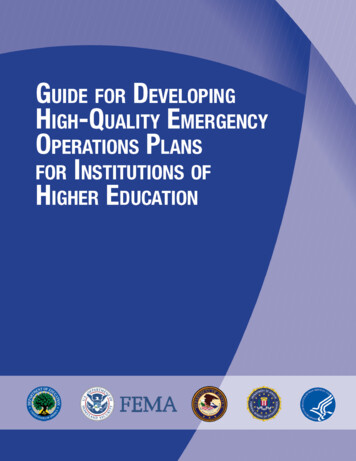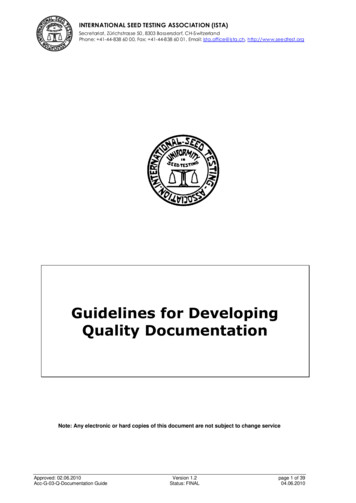
Transcription
GUIDE FOR DEVELOPINGHIGH-QUALITY EMERGENCYOPERATIONS PLANSFOR INSTITUTIONS OFHIGHER EDUCATIONU.S. Department of EducationU.S. Department of Health and Human ServicesU.S. Department of Homeland SecurityU.S. Department of JusticeFederal Bureau of InvestigationFederal Emergency Management Agency2013
This report was prepared for the U.S. Department of Education under Contract Number EDESE12O0036 with SynergyEnterprises, Inc. Madeline Sullivan served as the contracting officer’s representative for the Readiness and EmergencyManagement for Schools (REMS) Technical Assistance (TA) Center. The views expressed herein represent the collectiveexpertise of the federal agencies issuing this document. No official endorsement by the U.S. Department of Educationof any product, commodity, service, or enterprise mentioned in this publication is intended or should be inferred. Forthe reader’s convenience, this publication contains information about and from outside organizations, includinghyperlinks and URLs. Inclusion of such information does not constitute an endorsement by the Department.U.S. Department of EducationArne DuncanSecretaryOffice of Elementary and Secondary EducationDeborah S. DelisleAssistant SecretaryOffice of Safe and Healthy StudentsDavid EsquithDirectorJune 2013This report is in the public domain. Authorization to reproduce the report in whole or in part is granted. Whilepermission to reprint this publication is not necessary, the suggested citation is: U.S. Department of Education, Office ofElementary and Secondary Education, Office of Safe and Healthy Students, Guide for Developing High-Quality EmergencyOperations Plans for Institutions of Higher Education, Washington, DC, 2013.To obtain copies of this report,Download online at Office of Safe and Healthy Students, 2013. Emergency Planning Webpage. Available lan/index.html, orReadiness and Emergency Management for Schools (REMS) Technical Assistance (TA) Center, 2013. Available athttp://rems.ed.gov/EOPGuides.Availability of Alternate FormatsRequests for documents in alternate formats such as Braille or large print should be submitted to the Alternate FormatCenter by calling 202-260-0852 or by contacting the 504 coordinator via e-mail at om eeos@ed.gov.Notice to Limited English Proficient PersonsIf you have difficulty understanding English you may request language assistance services for Department informationthat is available to the public. These language assistance services are available free of charge. If you need moreinformation about interpretation or translation services, please call 1-800-USA-LEARN (1-800-872-5327) (TTY: 1-800437-0833), or e-mail us at ED.Language.Assistance@ed.gov. Or write to U.S. Department of Education, InformationResource Center, LBJ Education Building, 400 Maryland Ave. SW, Washington, DC 20202.
ContentsIntroduction and Purpose . 1Planning Principles . 5The Planning Process . 6Step 1: Form a Collaborative Planning Team . 6Step 2: Understand the Situation . 16Step 3: Determine Goals and Objectives . 20Step 4: Plan Development (Identifying Courses of Action) . 23Step 5: Prepare, Review, and Approve the Plan . 25Step 6: Implement and Maintain the Plan . 28Plan Content . 31The Basic Plan . 31Introductory Material . 32Purpose and Situation Overview . 32Concept of Operations . 33Functional Annexes Content . 36Threat- and Hazard-Specific Annexes . 44A Closer Look . 461. The Jeanne Clery Disclosure of Campus Security Policy and Campus CrimeStatistics Act (the Clery Act) . 472. Information Sharing. 52Family Educational Rights and Privacy Act (FERPA) . 53Health Insurance Portability and Accountability Act of 1996 (HIPAA) . 693. Incorporating International Students into IHE Emergency Management andPlanning . 714. Campus Public Safety . 735. Active Shooter Situations . 756. Psychological First Aid (PFA). 86List of TablesTable 1: Contributions to the Planning Team . 7i
Table 2: Assessments. 18Table 3: Sample Risk Assessment Workshop . 20Table 4: Threat and Hazard Types and Examples . 45List of FiguresFigure 1: Steps in the Planning Process . 6Figure 2: Traditional EOP Format . 26ii
INTRODUCTION AND PURPOSEOur nation’s postsecondary institutions are entrusted to provide a safe and healthy learningenvironment for students, faculty, and staff who live, work, and study on campus. Faced withemergencies ranging from active shooter situations to fires, tornadoes, floods, hurricanes,earthquakes, and pandemic influenza, this is no easy task. Many of these emergencies occur withlittle to no warning; therefore, it is critical for institutions of higher education (IHEs) to planahead to help ensure the safety and general welfare of all members of the campus community.IHEs face unique challenges in planning for potential emergencies in terms of geography,environment, governance, and the population served. Colleges and universities, includingcommunity colleges and technical colleges, are large, small, urban, rural, residential, transient,two-year, four-year, public, and private, and often operate around-the-clock.IHE campuses often span large geographic areas, and many have additional locations in othercities, states, or countries. Many IHEs operate complex enterprises in addition to their academicprograms, including hospitals, research and development facilities, performing arts venues,athletic complexes, agricultural centers, residential complexes, and transportation systems. Theyfrequently have open campuses that are integrated into the surrounding community, with visitorsregularly on campus touring facilities, attending events, and receiving medical care.Many campuses house sensitive materials and information and sponsor activities and events thatincrease their vulnerability. It is common for major universities to employ people and establishfacilities dedicated to research in areas such as nuclear energy, engineering, biochemistry,medicine, public safety, defense, technology, and intelligence. In addition, many universitieshouse critical research. Major universities also serve as contractors to government agencies suchas the Department of Defense, Department of Justice, National Institutes of Health, NationalSecurity Agency, and the National Aeronautics and Space Administration, as well as to thenation’s largest corporations, and thus house important information.Additionally, IHE governance is highly varied and often widely dispersed. Many institutionshave decentralized organizational structures and academic departments with differing processesand decision-making responsibilities. In addition, the variance in purpose, structure, authority,and operations among campus police and security agencies makes one-size-fits-all programs andpolicies impractical.IHEs serve primarily adult students who are capable of making decisions on their own. Thecampus population is perpetually in flux, changing from day to day, semester to semester, andyear to year. Some students commute to and from campus, others attend class virtually, whilestill others live in housing facilities located on or near the college campus, resulting in adispersed population. IHEs also often host individuals from other nations.While these characteristics pose challenges, in collaboration with their local government andcommunity partners, IHEs can take steps to plan for these potential emergencies through thecreation of a higher education Emergency Operations Plan (higher ed EOP).Lessons learned from emergencies at IHEs highlight the importance of preparing IHE officialsand first responders to implement emergency operations plans. By having plans in place to keep1
students and staff safe, IHEs play a key role in taking preventative and protective measures tostop an emergency from occurring or reduce the impact of an incident. When an emergencyoccurs, IHE personnel must respond immediately, providing first aid, notifying responsepartners, and providing instruction before first responders arrive. IHE officials must work withpartners across the institution as well as their community partners (governmental organizationsthat have a responsibility in the IHE emergency operations plan) including first responders (lawenforcement officers, fire department officials, and emergency medical services [EMS]personnel), emergency managers, and public health and mental health practitioners to provide acohesive, coordinated response.It is recommended that planning teams at IHEs responsible for developing and revising a highered EOP use this document to guide their efforts. It is recommended that IHEs compare existingplans and processes against the content and process outlined in this guide. To gain the most fromit, users should read through the entire document prior to initiating their planning efforts and thenrefer back to it throughout the planning process.The guide is organized in four sections: The principles of emergency management planning for IHEs. A process for developing, implementing, and continually refining a higher ed EOP withcommunity partners. A discussion of the content of higher ed EOPs. “A Closer Look” which considers key topics that support emergency management forIHEs, including the Clery Act, information sharing, international students, psychologicalfirst aid, campus climate, campus law enforcement officers, and active shooter situations.As the team that developed this guide began its work to respond to the president’s call for modelemergency management plans for IHEs, it became clear that there is a need to help ensure thatcollege and university emergency planning efforts are aligned with the emergency planningpractices at the national, state, and local levels. Recent developments have put a new emphasison the process for developing higher ed EOPs.National preparedness efforts, including planning, are now informed by Presidential PolicyDirective (PPD)-8, which was signed by the president in March 2011 and describes the nation’sapproach to preparedness. This directive represents an evolution in our collective understandingof national preparedness, based on the lessons learned from terrorist attacks, hurricanes, schooland IHE incidents, and other experiences.PPD-8 defines preparedness around five mission areas: Prevention, Protection, Mitigation,Response, and Recovery.2
Prevention,1 for the purposes of this guide, means the capabilities necessary to avoid,deter, or stop an imminent crime or threatened or actual mass casualty incident. Preventionis the action IHEs take to prevent a threatened or actual incident from occurring. Protection means the capabilities to secure IHEs against acts of terrorism and man-madeor natural disasters. Protection focuses on ongoing actions that protect students, teachers,staff, visitors, networks, and property from a threat or hazard. Mitigation means the capabilities necessary to eliminate or reduce the loss of life andproperty damage by lessening the impact of an event or emergency. In this document,mitigation also means reducing the likelihood that threats and hazards will happen. Response means the capabilities necessary to stabilize an emergency once it has alreadyhappened or is certain to happen in an unpreventable way; establish a safe and secureenvironment; save lives and property; and facilitate the transition to recovery. Recovery means the capabilities necessary to assist IHEs affected by an event oremergency in restoring the learning environment.Emergency management officials and emergency responders engaging with IHEs are familiarwith this terminology. These mission areas generally align with the three timeframes associatedwith an incident: before, during, and after.The majority of Prevention, Protection, and Mitigation activities generally occur before anincident, although these three mission areas do have ongoing activities that can occur throughoutan incident. Response activities occur during an incident, and Recovery activities can beginduring an incident and occur after an incident. To help avoid confusion over terms and allow forease of reference, this guide uses “before”, “during”, and “after.”As IHEs plan for and execute response and recovery activities through the higher ed EOP, theyshould use the concepts and principles of the National Incident Management System (NIMS).One component of NIMS is the Incident Command System (ICS), which provides a standardizedapproach for incident management, regardless of cause, size, location, or complexity. By usingICS during an incident, IHEs will be able to more effectively work with the responders in theircommunities. For more information on ICS and NIMS, please see the Resources section.While some of the vocabulary, processes, and approaches discussed in this guide may be new tothe higher education community, they are critical. The vocabulary, processes, and approaches arecritical to the creation of emergency management practices and plans that are integrated with theefforts of first responders and other key stakeholders, and incorporate everything possible tokeep our campus communities safe. If an IHE has an existing plan, revising and adapting thatplan using the principles and process described in this guide will help ensure alignment with theterminology and approaches used across the nation.1In the broader PPD-8 construct, the term “prevention” refers to those capabilities necessary to avoid, prevent, orstop a threatened or actual act of terrorism. The term “prevention” also refers to preventing imminent threats.3
The Departments issuing this guidance are providing examples of good practices and matters toconsider for planning and implementation purposes. The guidance does not create anyrequirements beyond those included in applicable law and regulations, or create any additionalrights for any person, entity, or organization. The information presented in this documentgenerally constitutes informal guidance and provides examples that may be helpful. Theinclusion of certain references does not imply any endorsement of any documents, products, orapproaches. There may be other resources that may be equally helpful.This guide replaces Action Guide for Emergency Management at Institutions of HigherEducation (January 2010), which is rescinded.All websites listed in this guide were last accessed on June 3, 2013.4
PLANNING PRINCIPLESThe following principles are key to developing a comprehensive higher ed EOP that addresses arange of threats and hazards:Planning must be supported by IHE senior leadership. The IHE president, chancellor, orprovost initiates and supports planning efforts to help ensure engagement from the entire campuscommunity. Since budgetary realities may force campus administrators to make decisions withinselect fiscal parameters, it is important to have high-level support to provide both political andfinancial backing to the effort.Planning uses assessment to customize plans to the individual institution. Effective planningis built around comprehensive, ongoing assessment of the IHE’s unique physical, social, andenvironmental characteristics, including the academic programs offered, size and geographiclocation of the campus, the number and types of buildings and facilities (including athletic,health, and research facilities), the availability of campus and community resources, studentdemographics, campus law enforcement officers and security personnel, and pertinent physicalsecurity information.Planning considers all threats and hazards. The planning process must take into account awide range of possible threats and hazards that may impact the IHE. Comprehensive IHEemergency management planning considers all threats and hazards throughout the planningprocess, addressing safety needs before, during, and after an incident.Planning provides for the access and functional needs of the whole IHE community. The“whole IHE community” includes students, staff and visitors, including those with disabilitiesand others with access and functional needs, those from religiously, racially, and ethnicallydiverse backgrounds, and people with limited English proficiency.Planning considers all settings and all times. Higher ed EOPs must account for incidents thatmay occur at any hour of the day or night, in numerous buildings and off-campus sites or satellitelocations, including, but not limited to, laboratories and other facilities that house potentiallydangerous materials.Planning considers the individual preparedness of students, faculty, and staff. The planningteam should raise awareness of the importance of individual preparedness. Students should beinformed of the possibility of a prolonged shelter-in-place condition and should understand thatthey will be responsible for ensuring that they have the necessary supplies, such as access tosufficient medication.Planning meets the requirements of all applicable laws. A number of laws at all levels ofgovernment may apply to IHEs. For example, the Clery Act includes requirements for emergencyresponse and evacuation procedures, as well as timely warning and emergency notifications.Creating and revising a model emergency operations plan is done by following acollaborative process. This guide provides a process, plan format, and content guidance that areflexible enough for use by all IHE emergency planning teams. If a planning team also usestemplates, it must first evaluate their usefulness to ensure the tools do not undermine the5
collaborative initiative and collectively shared plan. There are some jurisdictions that providetemplat
Jun 03, 2013 · If you have difficulty understanding English you may request language assistance services for Department information that is available to the public. These language assistance services are available free of charge. If you need more information about interpretation or translation services,











